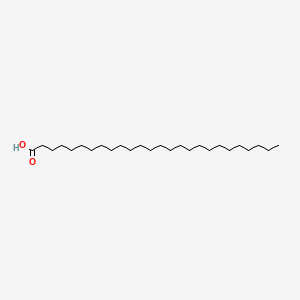| MeSH term | MeSH ID | Detail |
|---|---|---|
| Body Weight | D001835 | 333 associated lipids |
| Liver Diseases | D008107 | 31 associated lipids |
| Kidney Diseases | D007674 | 29 associated lipids |
| Leukemia P388 | D007941 | 43 associated lipids |
| Metabolism, Inborn Errors | D008661 | 46 associated lipids |
| Adrenoleukodystrophy | D000326 | 29 associated lipids |
| Diffuse Cerebral Sclerosis of Schilder | D002549 | 8 associated lipids |
| Arteriosclerosis | D001161 | 86 associated lipids |
| Metabolic Diseases | D008659 | 12 associated lipids |
| Adrenocortical Hyperfunction | D000308 | 3 associated lipids |
HEXACOSANOIC ACID
HEXACOSANOIC ACID is a lipid of Fatty Acyls (FA) class. Hexacosanoic acid is associated with abnormalities such as Adrenoleukodystrophy, Adrenal gland hypofunction and Chronic liver disease NOS. The involved functions are known as peroxisome targeting signal-2 binding activity, Oxidation, Demyelination, Mutation and Biosynthetic Pathways. Hexacosanoic acid often locates in peroxisome, Body tissue, Mitochondria, Membrane and Cytoplasm. The associated genes with HEXACOSANOIC ACID are ABCD1 gene, TRAM1 gene, GPX1 gene, SOD1 gene and SOD2 gene. The related lipids are Fatty Acids, Stearic acid, inositolphosphorylceramide, Very long chain fatty acid and Nonesterified Fatty Acids. The related experimental models are Knock-out.
Cross Reference
Introduction
To understand associated biological information of HEXACOSANOIC ACID, we collected biological information of abnormalities, associated pathways, cellular/molecular locations, biological functions, related genes/proteins, lipids and common seen animal/experimental models with organized paragraphs from literatures.
What diseases are associated with HEXACOSANOIC ACID?
HEXACOSANOIC ACID is suspected in Adrenoleukodystrophy, Adrenal gland hypofunction, Chronic liver disease NOS and other diseases in descending order of the highest number of associated sentences.
Related references are mostly published in these journals:
| Disease | Cross reference | Weighted score | Related literature |
|---|
Possible diseases from mapped MeSH terms on references
We collected disease MeSH terms mapped to the references associated with HEXACOSANOIC ACID
PubChem Associated disorders and diseases
What pathways are associated with HEXACOSANOIC ACID
There are no associated biomedical information in the current reference collection.
PubChem Biomolecular Interactions and Pathways
Link to PubChem Biomolecular Interactions and PathwaysWhat cellular locations are associated with HEXACOSANOIC ACID?
Visualization in cellular structure
Associated locations are in red color. Not associated locations are in black.
Related references are published most in these journals:
| Location | Cross reference | Weighted score | Related literatures |
|---|
What functions are associated with HEXACOSANOIC ACID?
Related references are published most in these journals:
| Function | Cross reference | Weighted score | Related literatures |
|---|
What lipids are associated with HEXACOSANOIC ACID?
Related references are published most in these journals:
| Lipid concept | Cross reference | Weighted score | Related literatures |
|---|
What genes are associated with HEXACOSANOIC ACID?
Related references are published most in these journals:
| Gene | Cross reference | Weighted score | Related literatures |
|---|
What common seen animal models are associated with HEXACOSANOIC ACID?
Knock-out
Knock-out are used in the study 'A key role for the peroxisomal ABCD2 transporter in fatty acid homeostasis.' (Fourcade S et al., 2009).
Related references are published most in these journals:
| Model | Cross reference | Weighted score | Related literatures |
|---|
NCBI Entrez Crosslinks
All references with HEXACOSANOIC ACID
Download all related citations| Authors | Title | Published | Journal | PubMed Link |
|---|---|---|---|---|
| Yuan C et al. | Mychonastes afer HSO-3-1 as a potential new source of biodiesel. | 2011 | Biotechnol Biofuels | pmid:22040677 |
| López-Erauskin J et al. | Antioxidants halt axonal degeneration in a mouse model of X-adrenoleukodystrophy. | 2011 | Ann. Neurol. | pmid:21786300 |
| Veerapen N et al. | Synthesis of truncated analogues of the iNKT cell agonist, α-galactosyl ceramide (KRN7000), and their biological evaluation. | 2011 | Bioorg. Med. Chem. | pmid:21145749 |
| Xue Q et al. | Two new compounds from Semen celosiae and their protective effects against CClâ‚„-induced hepatotoxicity. | 2011 | Nat. Prod. Res. | pmid:20306359 |
| Bai Y et al. | Active components from Siberian ginseng (Eleutherococcus senticosus) for protection of amyloid β(25-35)-induced neuritic atrophy in cultured rat cortical neurons. | 2011 | J Nat Med | pmid:21301979 |
| Ryabova NY et al. | Investigation of stratum corneum lipid model membranes with free fatty acid composition by neutron diffraction. | 2010 | Eur. Biophys. J. | pmid:20012954 |
| Fourcade S et al. | Valproic acid induces antioxidant effects in X-linked adrenoleukodystrophy. | 2010 | Hum. Mol. Genet. | pmid:20179078 |
| Hsu WY et al. | Screening assay of very long chain fatty acids in human plasma with multiwalled carbon nanotube-based surface-assisted laser desorption/ionization mass spectrometry. | 2010 | Anal. Chem. | pmid:20704371 |
| Jardim LB et al. | X-linked adrenoleukodystrophy: clinical course and minimal incidence in South Brazil. | 2010 | Brain Dev. | pmid:19269120 |
| Khan MA et al. | Phytochemical investigation of the fruit peels of Citrus reticulata Blanco. | 2010 | Nat. Prod. Res. | pmid:20401792 |
